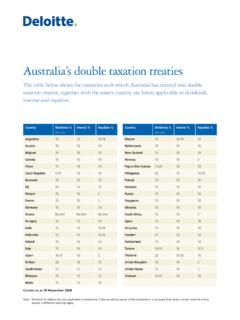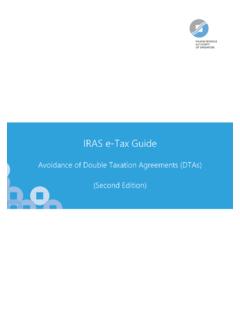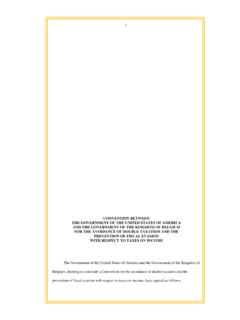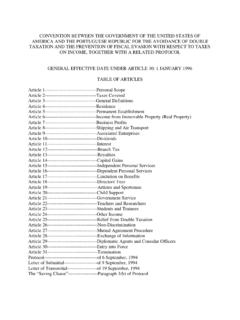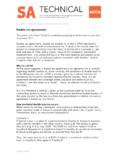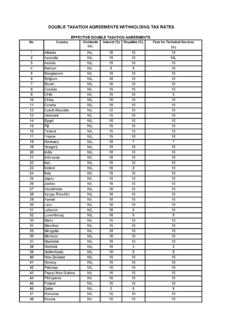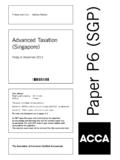Transcription of United Nations Model Double Taxation Convention
1 Printed at the United Nations , New York12-23972 March 2012 2,715 USD 45 ISBN 978-92-1-159102-6 United Nations Model Double TaxationConvention between Developed and Developing CountriesUnited Nations Model Double Taxation Convention between Developed and Developing CountriesasdfUnited Nations New York, 2011 Department of Economic & Social AffairsUnited NationsModelDouble TaxationConventionbetween Developedand Developing CountriesiiiCONTENTSPageINTRODUCTION .. vi A. Origin of the United Nations Model Convention .. vi B. Special characteristics of the United Nations Model Convention .. ix C. Main features of this revision of the United Nations Model Convention .. xi D. The Commentaries .. xiiPart One Articles of the United Nations Model Double Taxation Convention between Developed and Developing CountriesChapter SUMMARY OF THE Convention .
2 3 TITLE AND PREAMBLE .. 5 I. SCOPE OF THE Convention (Articles 1 and 2) .. 7 II. DEFINITIONS (Articles 3 to 5) .. 8 III. Taxation OF INCOME (Articles 6 to 21) .. 12 IV. Taxation OF CAPITAL (Article 22) .. 26 V. METHODS FOR THE ELIMINATION OF Double TA X ATION (Article 23) .. 27 VI. SPECIAL PROVISIONS (Articles 24 to 28) .. 29 VII. FINAL PROVISIONS (Articles 29 to 30) .. 37Pa r t Tw o Commentaries on the Articles of the United Nations Model Double Taxation Convention between Developed and Developing CountriesCOMMENTARY ON CHAPTER I: SCOPE OF THE Convention .. 41 Article 1: Persons covered .. 41 Article 2: Taxes covered .. 79ivPageCOMMENTARY ON CHAPTER II: DEFINITIONS .. 83 Article 3: General 83 Article 4: Resident .. 87 Article 5: Permanent 96 COMMENTARY ON CHAPTER III: Taxation OF INCOME.
3 137 Article 6: Income from immovable property .. 137 Article 7: Business profits .. 139 Article 8: Shipping, inland waterways transport and air transport .. 162 Article 9: Associated 170 Article 10: Dividends .. 176 Article 11: Interest .. 192 Article 12: Royalties .. 207 Article 13: Capital gains .. 225 Article 14: Independent personal services .. 237 Article 15: Dependent personal services .. 241 Article 16: Directors fees and remuneration of top-level managerial officials .. 262 Article 17: Artistes and sportspersons .. 263 Article 18: Pensions and social security payments .. 269 Article 19: Government service .. 289 Article 20: Students .. 294 Article 21: Other income .. 299 COMMENTARY ON CHAPTER IV: Taxation OF CAPITAL . 305 Article 22: Capital.
4 305 COMMENTARY ON CHAPTER V: METHODS FOR THE ELIMINATION OF Double Taxation .. 308 Article 23: Methods for the elimination of Double Taxation 308 COMMENTARY ON CHAPTER VI: SPECIAL PROVISIONS .. 339 Article 24: Non-discrimination .. 339 Article 25: Mutual agreement procedure .. 366vPage Article 26: Exchange of information .. 435 Article 27: Assistance in the collection of taxes .. 470 Article 28: Members of diplomatic missions and consular posts .. 480 COMMENTARY ON CHAPTER VII: FINAL PROVISIONS .. 483 Articles 29 and 30: Entry into force and termination .. 483viIntroductionINTRODUCTIONA. ORIGIN OF THE United Nations Model Convention 1. The United Nations Model Double Taxation Convention between Developed and Developing Countries (the United Nations Model Convention ) forms part of the continuing international efforts aimed at elim-inating Double Taxation .
5 These efforts were begun by the League of Nations and pursued in the Organisation for European Economic Co-operation (OEEC) (now known as the Organisation for Economic Co-operation and Development (OECD)) and in regional forums, as well as in the United Nations , and have in general found concrete expression in a series of Model or draft Model bilateral tax These Models, particularly the United Nations Model Convention and the OECD Model Tax Convention on Income and on Capital (the OECD Model Convention ) have had a profound influence on international treaty practice, and have significant common provisions. The similarities between these two leading Models reflect the importance of achieving consistency where possible. On the other hand, the important areas of divergence exem-plify, and allow a close focus upon, some key differences in approach or emphasis as exemplified in country practice.
6 Such differences relate, in par-ticular, to the issue of how far one country or the other should forego, under a bilateral tax treaty, taxing rights which would be available to it under domes-tic law, with a view to avoiding Double Taxation and encouraging The United Nations Model Convention generally favours retention of greater so called source country taxing rights under a tax treaty the taxa-tion rights of the host country of investment as compared to those of the residence country of the investor. This has long been regarded as an issue of special significance to developing countries, although it is a position that some developed countries also seek in their bilateral The desirability of promoting greater inflows of foreign invest-ment to developing countries on conditions which are politically accept-able as well as economically and socially beneficial has been frequently affirmed in resolutions of the General Assembly and the Economic and Social Council of the United Nations and the United Nations Conference on Trade and Development.
7 The 2002 Monterrey Consensus on Financing for Development1 and the follow up Doha Declaration on Financing for 1 United Nations 2002, viiIntroductionDevelopment of 20082 together recognize the special importance of inter-national tax cooperation in encouraging investment for development and maximizing domestic resource mobilisation, including by combating tax evasion. They also recognize the importance of supporting national efforts in these areas by strengthening technical assistance (in which this Model will play a vital part) and enhancing international cooperation and participation in addressing international tax matters (of which the United Nations Model Convention is one of the fruits).5. The growth of investment flows between countries depends to a large extent on the prevailing investment climate. The prevention or elimination of international Double Taxation in respect of the same income - the effects of which are harmful to the exchange of goods and services and to the move-ment of capital and persons, constitutes a significant component of such a Broadly, the general objectives of bilateral tax treaties therefore include the protection of taxpayers against Double Taxation with a view to improving the flow of international trade and investment and the transfer of technology.
8 They also aim to prevent certain types of discrimination as between foreign investors and local taxpayers, and to provide a reasonable element of legal and fiscal certainty as a framework within which interna-tional operations can confidently be carried on. With this background, tax treaties should contribute to the furtherance of the development aims of developing countries. In addition, the treaties seek to improve cooperation between taxing authorities in carrying out their functions, including by the exchange of information with a view to preventing avoidance or evasion of taxes and by assistance in the collection of The desirability of encouraging the conclusion of bilateral tax trea-ties between developed and developing countries was recognized by the Economic and Social Council (ECOSOC) of the United Nations , in its res-olution 1273 (XLIII) adopted on 4 August 1967.
9 This led to the Secretary-General setting up in 1968 the Ad Hoc Group of Experts on Tax Treaties between Developed and Developing Countries. The Group was composed of tax officials and experts from both developing and developed countries, appointed in their personal In 1980, the United Nations published, as a result of the Ad Hoc Group of Experts deliberations, the United Nations Model Double Taxation Convention between Developed and Developing Countries, which was pre-ceded in 1979 by the Manual for the Negotiation of Bilateral Tax Treaties 2 United Nations 2008, Developed and Developing Countries (the Manual). By its resolu-tion 1980/13 of 28 April 1980, the Economic and Social Council renamed the Group of Experts as the Ad Hoc Group of Experts on International Cooperation in Tax Matters (the Ad Hoc Group of Experts) recognizing the importance of non tax treaty-related international tax cooperation In the 1990s, the Ad Hoc Group of Experts recognized that signifi-cant changes had taken place in the international economic, financial and fiscal environment.
10 In addition, there was increasing focus on tax impacts of new financial instruments, transfer pricing, the growth of tax havens and globalization affecting international economic relations. The increasingly frequent updates to the OECD Model Convention contributed to the need for an ongoing review of process of greater reflection on international tax coop-eration issues. Consequently, the Ad Hoc Group of Experts proceeded with the revision and update of the United Nations Model Convention and the Manual. This led to a new version of the United Nations Model Convention (revised in 1999 and published in 20013) and a new version of the Manual (published electronically in 20034).10. In 2005 the Ad Hoc Group of Experts was upgraded by conversion into a Committee structure, which remains its current form.










